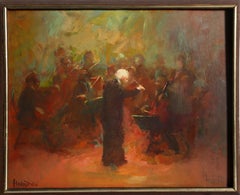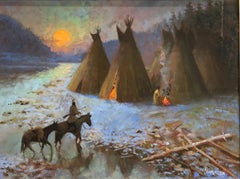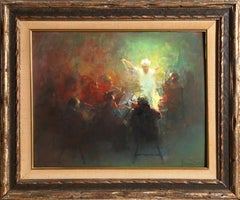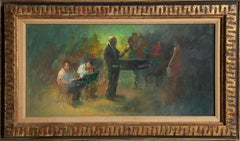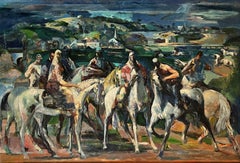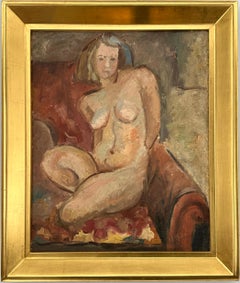William Harnden Art
to
2
5
5
5
3
2
Overall Height
to
Overall Width
to
3
5
3
2
2
2
1
1
1
1
1
1
1
5
3
5
6,886
3,209
2,514
1,217
5
5
3
3
2
Artist: William Harnden
Conductor with Orchestra, Figurative Oil Painting by William Harnden
By William Harnden
Located in Long Island City, NY
Artist: William Harnden, American (1920 - 1983)
Title: Conductor with Orchestra
Medium: Oil on Masonite, signed
Image Size: 15.5 x 19 inches
Frame Size: 18 x 21 inches
Category
1950s American Modern William Harnden Art
Materials
Masonite, Oil
Coming Home at Sunset
By William Harnden
Located in Greenville, DE
Very well executed work by American artist William Harnden who specialized in Native American subjects. 23 3/4 x 29 1/2 in excellent condition frame.
Category
Mid-20th Century Realist William Harnden Art
Materials
Oil, Board
Native American Encampment
By William Harnden
Located in Greenville, DE
Very well executed work by American artist William Harnden who specialized in Native American subjects. 23 3/4 x 29 1/2 in excellent condition frame.
Category
Mid-20th Century Realist William Harnden Art
Materials
Oil, Board
Concert, Figurative Oil Painting by William Harnden
By William Harnden
Located in Long Island City, NY
Artist: William Harnden, American (1920 - 1983)
Title: Concert
Medium: Oil on Masonite, signed
Image Size: 15.5 x 20 inches
Frame Size: 22.5 x 27 inches
Category
1950s American Modern William Harnden Art
Materials
Masonite, Oil
Conductor and Singer, Figurative Oil Painting by William Harnden
By William Harnden
Located in Long Island City, NY
Artist: William Harnden, American (1920 - 1983)
Title: Conductor with Singer
Medium: Oil on Masonite, signed
Image Size: 11.5 x 23.5 inches
Frame Size: 17.5 x 30 inches
Category
1950s American Modern William Harnden Art
Materials
Masonite, Oil
Related Items
Riders of Pigeon Hill
By Jon Corbino
Located in Los Angeles, CA
Riders of Pigeon Hill, c. 1940s, oil on canvas, signed lower right, 24 x 36 inches, label verso with title, artist’s name and address; same information inscribed verso; ex-collection...
Category
1940s American Modern William Harnden Art
Materials
Canvas, Oil
The Artist's Wife oil painting by Hans Burkhardt
By Hans Burkhardt
Located in Hudson, NY
Hans Burkhardt
The Artist's Wife (1930)
Oil on canvas, 20" x 16"
24" x 20 ½" x 1 ½" framed
Dated 1930 lower right recto. Annotated "To Elsa HB Louise Burkhardt 1930. HB" verso.
...
Category
1930s American Modern William Harnden Art
Materials
Oil, Canvas
The Demogogue
Located in Los Angeles, CA
The Demagogue or Tale in a Tub, 1952, oil on canvas, 20 x 24 inches, signed, titled, and dated verso
About the Painting
The Demagogue is an iconic Bendor Mark painting from the prime of his post-war period. Beginning early in his career, Mark was fascinated with depictions of the human figure and their capacity to tell stories of the world around him. Mark was a keen observer of his times and in The Demagogue we see Mark’s portrayal of a faithless politician holding up a “V” for victory sign as he appeals to the wanton desires and prejudices of the masses. Below the demagogue is a swirl of humanity representing the common man who is being pushed down by the powerful, while the robed figure of liberty with her scales of justice held high is brushed aside. Behind the demagogue, Mark places two other powerful supporting institutions which were often co-opted by the world’s dictators, the Church and the Military. Mark was an internationalist, so it is difficult to know exactly which demagogue inspired him to create this work, but in 1952 there were many to choose from. Whether depicting Argentina’s Peron (the demagogue and the women to the right resemble Juan and Eva Peron), Spain’s Franco or the United States’ homegrown fear mongers like Joseph McCarthy, Mark tells a universal story that unfolded in dramatic fashion during the post-war period as nations and their peoples grappled with authoritarianism and anti-democratic impulses. Stylistically, The Demagogue draws on the elements which make Mark’s work from this period immediately recognizable, a saturated palette, a closely packed and frenetic composition, exaggerated figuration and stylized facial features. But, above all, we see Mark’s ability to tell the stories of the rich and powerful and their ability to oppress. Like Mark’s work in the collection of the Whitney Museum of American Art (The Hourglass - 1950-51) and the Los Angeles County Museum of Art (Execution – 1940), The Demagogue pulls no punches, as the artist lays bare the threats to freedom and basic human rights.
About the Artist
Bendor Mark was an American modernist and social realist painter. Born as Bernard Marcus on June 5, 1912, in Brooklyn, New York, Mark trained at The Cooper Union during the 1920s where he studied with William Brantley van Ingen and became a prize-winning artist with a focus on painting the human figure. After his time at Cooper, Mark continued to live in New York and worked as a commercial artist and textile designer in addition to his pursuit of a career in painting. Like many Depression Era artists, Mark engaged with social progressives and in 1934, he joined the Artist’s Union which had the goal of advancing artists’ position as “worker.” Mark’s painting, Restaurant, which is now in the permanent collection of the Smithsonian American Art Museum, appeared in the February 1936 edition of the Union’s publication, Art Front, as part of a review of an exhibition at ACA Gallery in New York.
Mark worked on the Federal Art Project and by the mid- to late-1930s, began a series of paintings exploring the working conditions and hazards of the mining industry. Mark believed that miners were “in the forefront of the struggle for emancipation” and that the mere “struggle for existence is like moving mountains.” He became passionate about the Spanish Civil War and painted sympathetic images in support of the Spanish Republic. Mark was a premature anti-fascist and throughout his career painted works critical of dictators and other oppressors. During the late 1930s, Mark entered mural competitions with designs influenced by the Mexican muralists, taught adult art education in Queens, New York, and was an instructor at the WPA’s Queensboro Art Center. He was so committed to socially progressive art that by 1934, he had changed his name to Bendor Mark, in part, to distinguish his social realist paintings from his earlier work.
During World War II, Mark worked as an artist for military contractors. After the war, he was employed as a graphic artist and in the printing industry before moving to Southern California in 1948, where he returned to a fine art practice the following year with politically and socially charged images which reflected his view of the shortcomings of the post-War period, the continued threat of fascism, and the international tensions of the Cold War. As the mood of the country shifted towards the right during the McCarthy Era and the art world’s attention focused on abstraction at the expense of figuration, Mark’s career as a painter suffered.
From the 1950s through the 1980s, Mark continued to depict the events that shaped the world around him, often employing a highly stylized approach characterized by dynamic multi-figure compositions, a subtle muted palette, and exaggerated expressive features. A review of Mark’s oeuvre suggests that few people escaped Mark’s attention. He painted presidents, prime ministers, royalty, evangelists, musicians, and dictators (and their henchman), along with miners, farm workers, the urban poor, protesters, the unemployed and dispossessed. He laid bare the arrogance, cruelty, and hypocrisy of the world’s elites. Mark noted, “A work of art cannot be fully appreciated or wholly understood without considering the socio-political and cultural ambience that gave it birth.” He continued, “I have the ability to foresee the direction of social and political events while they are actually taking place.” He was not himself a direct political activist, however. Although Mark commented, “It’s a misconception to separate art from the social aspect of life,” he viewed artists as being neutral. According to Mark, “An apolitical attitude reflects the fact that the artist is passive. . . An artist never affects society; he merely reflects it.”
In addition to the Mexican Muralists, Mark was influenced by the old masters Rembrandt, Michelangelo, and Masaccio, as well as the more modern master, Van Gogh. Mark’s writings directly acknowledge these influences and archival material from his estate includes magazine articles, pamphlets and transparencies related to these artists. Mark also collected materials related to several of his social realist contemporaries, including Reginald Marsh, Ben Shahn, Leonard Baskin, and Raphael Soyer, who was Mark’s good friend. For years, Soyer sent Mark holiday cards and Soyer inscribed a message of friendship on a self-portrait he gifted to Mark in the 1970s, all of which are still held in the collection of Mark’s family.
From the late 1920s through the mid-1950s, Mark’s work was well received. His paintings won prizes and were accepted into major juried exhibitions including at the Brooklyn Museum, the New York World’s Fair and the Metropolitan Museum of Art. He gained national recognition for paintings depicting the oppressed and the common worker. Despite the decline in popularity of representational art during the 1950s and 1960s, Mark stayed true to his interest in depicting the human figure and by the last two decades of his life, his work underwent a reassessment as curators included Mark’s paintings in exhibitions showcasing the role of labor in art during the Depression Era. This recognition continued in recent years when Mark was honored by having his work included in the Whitney Museum of American Art’s ground-breaking exhibition, Vida Americana, which explored the pioneering role that the Mexican muralists played in the development of modern American art during the inter-war period. The influence of Rivera, Siqueiros and Orozco on Mark is unmistakable and his paintings from the 1950s (and beyond) sit comfortably in dialogue with other Los Angeles artists who continued to paint in the social realist tradition long after the mainstream art world had moved toward abstraction. Mark’s concern for underserved Brown and Black communities was shared with artists such as Charles White and his ally, Edward Biberman...
Category
Mid-20th Century American Modern William Harnden Art
Materials
Canvas, Oil
Sailboats and Sailing Ship in Seascape early 20th Century Oil Painting Framed
Located in Stockholm, SE
This artwork showcases the beauty of sailing boats and ships sailing gracefully on the sea waters. The artist's attention to detail is evident in the intricate depiction of the ships...
Category
Early 20th Century Realist William Harnden Art
Materials
Wood, Oil, Cardboard
French Genre Scene in Parisian park 19th Century Oil painting
By Emile Tabary
Located in Stockholm, SE
Signed by Émile Tabary. Lively scene in in a parisian park, pictured moment of city life of the late 19th century. In this painting, some irony and humor are very subtly felt. One of...
Category
Late 19th Century Realist William Harnden Art
Materials
Oil, Cardboard
Free Shipping
H 36.6 in W 30 in
Surroundings in countryside. 1963, cardboard, oil, 45 x 58 cm
Located in Riga, LV
Surroundings in countryside. 1963, cardboard, oil, 45 x 58 cm
Landscape painting of Latvia countryside.
Gentle and careful brushstrokes in the foreground accents sunny day.
Color u...
Category
1960s Realist William Harnden Art
Materials
Cardboard, Oil
H 17.72 in W 22.84 in D 0.08 in
Neon Lighting WPA Mid 20th Century Social Realism American Scene Modern Figures
By Maurice Becker
Located in New York, NY
Neon Lighting WPA Mid 20th Century Social Realism American Scene Modern Figures
MAURICE BECKER (1889-1975)
'Neon Lighting
17 1/4 x 13 3/4 inches
Oil on masonite
Signed, dated 1936 and titled on verso
BIO
Maurice Becker, painter, political cartoonist and social reformer, was born in 1889 either in Gorky or Niznij Novgorod, in Russia. His family came to the United States in 1892, to New York City. After high school, Becker worked in a clothing factory. He studied with Ash Can School artist Robert Henri in 1908, and exhibited in the famous 1913 Armory Show in New York City when he was only twenty-four years of age.
At the Armory show, Becker showed a drawing of a dog's head...
Category
1930s American Modern William Harnden Art
Materials
Masonite, Oil
Beach with dunes oil paint on board seascape
By Alberto Biesok
Located in Barcelona, Barcelona
Born in Valencia but with German and Mediterranean roots, his artistic work has been focused on exhibitions around the idea of "landscape", within a formal pictorial and drawing po...
Category
2010s Realist William Harnden Art
Materials
Board, Oil
Forgotten Fence /// Realism Landscape Country Farm River Painting American Art
By Adolf Sehring
Located in Saint Augustine, FL
Artist: Adolf Sehring (Russian/German-American, 1930-2015)
Title: "Forgotten Fence"
*Signed by Sehring lower right
Circa: 1970
Medium: Original Oil Paint...
Category
1970s Realist William Harnden Art
Materials
Paint, Oil, Board, Panel, Wood Panel
Twilight Serenity at Sea, Maritime Painting by Swedish Artist Per Linér, 1800s
Located in Stockholm, SE
This exquisite painting by Per Linér, a distinguished Swedish artist born in the 19th century, eloquently captures the serene maritime essence of what appears to be the Helsingborg region. The canvas is brought to life with a selection of ships that grace the calm waters, suggesting the vibrant trade and seafaring culture of the era. At the heart of the composition lies an island, crowned with modest yet intriguing buildings that hint at human habitation amidst the vastness of nature. Linér's masterful use of a soft, rosy hue in the sky evokes a time of day when the sun's final embers paint the heavens, offering viewers a moment of reflective tranquility. The painting's historical significance is matched by its visual splendor, making it a valuable addition to any collection of classic Scandinavian landscapes. This artwork not only showcases Linér's academic training in Stockholm and Germany but also his deep connection to the landscapes around him, which he chronicled with dedication throughout his career.
oil on board
signed with monogram PL...
Category
Late 19th Century Realist William Harnden Art
Materials
Oil, Board
Untitled (Elevated Platform)
Located in Los Angeles, CA
This painting is part of our current exhibition - America Coast to Coast: Artists of the 1940s
Untitled (Elevated Platform), 1950, oil on canvas, signed and dated lower right, 30 x...
Category
1950s American Modern William Harnden Art
Materials
Canvas, Oil
Africa - Collage Painting in Orange - African American Artist
Located in Miami, FL
African American artist Alvin Hollingsworth created an inventive and intriguing close-up portrait with figures in the distance. Found objects such as swatches of burlap, plastic spoons, press type and wood shapes are adhered to the surface make this work an object as much as an image. The overall image is bathed in a super hot orange-yellow. This is Hollingsworth interpretation of the soul of Africa. Indistinctly signed lower right in red. The work makes a powerful statement in person.
Provenance: The Artist to a personal friend. Private collection
Framed dimensions 19 1/4 x 25 1/4 in.
Alvin Carl...
Category
1980s American Modern William Harnden Art
Materials
Fabric, Burlap, Wood, Oil
H 18.2 in W 24.4 in D 2 in
William Harnden art for sale on 1stDibs.
Find a wide variety of authentic William Harnden art available for sale on 1stDibs. You can also browse by medium to find art by William Harnden in oil paint, paint, masonite and more. Much of the original work by this artist or collective was created during the 20th century and is mostly associated with the modern style. Not every interior allows for large William Harnden art, so small editions measuring 21 inches across are available. Customers who are interested in this artist might also find the work of Arnold Blanch, Harold Vincent Skene, and Alfred Wands. William Harnden art prices can differ depending upon medium, time period and other attributes. On 1stDibs, the price for these items starts at $1,800 and tops out at $5,500, while the average work can sell for $2,000.
